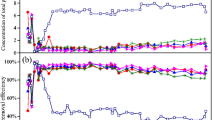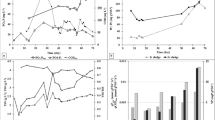Abstract
The effect of the different carbon sources acetate, acetate/glucose or glucose on the enhanced biological phosphorus removal (EBPR) process was studied by experiments under alternating anaerobic–aerobic conditions in one sequencing batch reactor for each carbon source. The glucose was consumed completely within the first 30 min of the anaerobic phase whereas acetate degradation was slow and incomplete. Phosphate was released independently of the carbon source during the whole anaerobic phase. The highest phosphate release (27 mg P l−1) and polyhydroxyalkanoate (PHA) storage (20 mg C g−1 dry matter (DM)) during the anaerobic phase as well as the highest polyphosphate (poly-P) (8 mg P g−1 DM) and glycogen storage (17 mg C g−1 DM) during the aerobic phase were observed with acetate. In contrast to other investigations, glycogen storage did not increase with glucose as substrate but was significantly smaller than with acetate. The PHA composition was also influenced strongly by the carbon source. The polyhydroxyvalerate (PHV) portion of the PHA was maximal 17% for acetate and 82% for glucose. Due to the strong influence of the carbon source on the PHA concentration and composition, PHA storage seems to regulate mainly the phosphate release and uptake.
Similar content being viewed by others
References
Carucci, A., Lindrea, K., Majone, M. & Ramadori, R. 1995 Dynamics of the anaerobic utilization of organic substrates in an anaerobic/aerobic sequencing batch reactor. Water Science and Technology 31` 35–43.
Carucci, A., Majone, M. & Ramadori, R. 1997 Biological phosphorus removal with different organic substrates in an anaerob/aerob sequencing batch reactor. Water Science and Technology 35, 161–168.
Carucci, A., Lindrea, K., Majone, M., & Ramadori, R. 1999 Different mechanisms for the anaerobic storage of organic substrates and their effect on enhanced biological phosphate removal (EBPR). Water Science and Technology 39, 21–28.
Cech, J.S. & Hartman, P. 1990 Glucose induced break down of enhanced biological phosphate removal. Environmental Technology 11, 651–656.
Cech, J.S. & Hartman, P. 1993 Competition between polyphosphate and polysaccharide accumulating bacteria in enhanced biological phosphate removal systems. Water Science and Technology 27, 1219–1225.
Cech, J.S., Hartman, P. & Wanner, J. 1993 Competition between poly-P and non-poly-P bacteria in an enhanced phosphate removal system. Water Environmental Research 65, 690–692.
Clark, E.J., Beegen, H. & Wood, H.G. 1986 Isolation of intact chains of polyphosphates from 'Propionibacterium shermanii' grown on glucose or lactate. Journal of Bacteriology 168, 1212–1219.
Comeau, Y., Hall, K.J. & Oldham, W.K. 1988 Determination of poly-ß-hydroxybutyrate and poly-ß-hydroxyvalerate in activated sludge by gas-liquid chromatography. Applied and Environmental Microbiology 54, 2325–2327.
Eickelboom D.H. 1975 Filamentous organisms observed in activated sludge. Water Research 9, 365–388.
Füchtenbusch, B., Fabritius D. & Steinbüchel, A. 1996 Incorporation of 2-methyl-3-hydroxybutyric acid into polyhydroxyalkanoic acids by axenic cultures in de ned media. FEMS Microbiology Letters 138, 153–160.
Fukase, T., Shibata, M., & Miyaji, Y., 1984 The role of an anerobic stage on biological phosphorus removal. Water Science and Technology 17, 69–80.
Herbert, D., Phipps, P.J. & Strange, R.E. 1971 Chemical analysis of microbial cells. In Methods in microbiology vol. 5b. eds. Norris, J.R., Ribbons, D.W., London: Academic Press. ISBN 0-12-521545-2.
Jeon, C.O. & Park, J.M. 2000 Enhanced biological phosphorus removal in a sequencing batch reactor supplied with glucose as a sole carbon source. Water Research 34, 2160–2170.
Keppler, D. & Decker, K. 1974 Glykogen-Bestimmung mit Amyloglucosidase. In Methoden der enzymatischen Analyse vol 2, 3rd edn. ed. Bergmeyer, H.U. Weinheim: Verlag Chemie. ISBN 3-52725530-3.
Kuba, T., Wachtmeister, A., van Loosdrecht, M.C.M. & Heijnen, J.J. 1994 Effect of nitrate on phosphorus release in biological phosphorus removal systems. Water Science and Technology 30, 263–269.
Liu, W.T., Mino, T., Nakamura, K. & Matsuo, T. 1996 Glykogen accumulating population and its anaerobic substrate uptake in anaerobic-aerobic activated sludge without biological phosphorus removal. Water Research 30, 75–82.
Mino, T., van Loosdrecht M.C.M. & Heijnen J.J. 1998 Microbiology and biochemistry of the enhanced biological phosphate removal process. Water Research 11, 3193–3207.
Mino, T., Liu, W.-T., Kurisu, F. & Matsuo T. 1994 Modelling glycogen storage and denitrification capability of microorganisms in enhanced biological phosphate removal processes. Water Science and Technology 31, 25–34.
Nakamura, K., Masuda K. & Mikami, E. 1991 Isolation of a new type of polyphosphate accumulating bacterium and its phosphate removal characteristics. Journal of Fermentation and Bioengineering 71, 258–263.
Pereira, H., Lemos, P.C., Reis, M.A.M., Crespo, J.P.S., Carrondo M.J.T. & Santos H. 1996 Model for carbon metabolism in biological phosphorus removal processes based on in vivo 13C-NMR labelling experiments. Water Research 30, 2128–2138.
Petersen, B., Temmink, H., Henze, M. & Isaacs, S. 1998 Phosphate uptake kinetics in relation to PHB under aerobic conditions. Water Research 32, 91–100.
Pfennig, N. & Lippert, K.D. 1966 Über das Vitamin B12-Bedürf-nis phototropher Bakterien. Archives of Microbiology 55, 245–256.
Randall, A.A., Benefield, L.D. & Hill, W.E. 1994 The effect of fermentation products on enhanced biological phosphorus removal, polyphosphate storage, and microbial population dynamics. Water Science and Technology 30, 213–219.
Satoh, H., Mino, T. & Matsuo, T. 1992 Uptake of organic substrates and accumulation of polyhydroxyalkanoates linked with glycolysis of intracellular carbohydrates under anaerobic conditions in the biological excess phosphate removal processes. Water Science and Technology 26, 933–942.
Satoh, H., Mino, T. & Matsuo, T. 1994 Deterioration of enhanced biological phosphorus removal by the domination of microorganisms without polyphosphate accumulation. Water Science and Technology 30, 203–211.
Satoh, H., Ramey, W.D., Koch, F.A., Oldham, W.K., Mino, T. & Matsuo, T. 1996 Anaerobic substrate uptake by the enhanced biological phosphorus removal activated sludge treating real sewage. Water Science and Technology 34, 9–16.
Sudiana, I.M., Mino, T., Satoh, H., Nakamura, K. & Matsuo, T. 1999 Metabolism of enhanced biological phosphorus removal an non-enhanced biological phosphorus removal sludge with acetate and glucose as carbon source. Water Science and Technology 39, 29–35.
Tasli, R., Artan, N. & Orhon, D. 1997 The influence of different substrates on enhanced biological phosphorus removal in a sequencing batch reactor. Water Science and Technology 35, 75–80.
Wentzel, M.C., Lötter, L.H., Ekama, G.A., Loewenthal, R.E. & Marais, G.V.R. 1991 Evaluation of biochemical models for biological excess phosphorus removal. Water Science and Technology 23, 567–576.
Author information
Authors and Affiliations
Rights and permissions
About this article
Cite this article
Hollender, J., van der Krol, D., Kornberger, L. et al. Effect of different carbon sources on the enhanced biological phosphorus removal in a sequencing batch reactor. World Journal of Microbiology and Biotechnology 18, 359–364 (2002). https://doi.org/10.1023/A:1015258308460
Issue Date:
DOI: https://doi.org/10.1023/A:1015258308460




